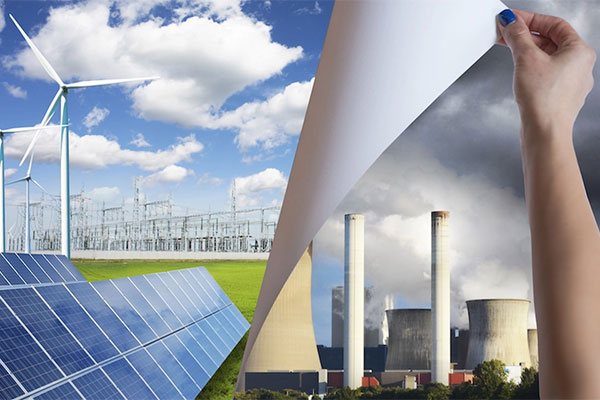- As solar + wind electricity ballooned by over 33%, renewables provided more electricity than either coal or nuclear power.
- Renewables accounted for 96% of new capacity and are on track to top 31% of generating capacity within three years.
Washington DC – According to a review by the SUN DAY Campaign of data newly released by the Federal Energy Regulatory Commission (FERC) and the U.S. Energy Information Administration (EIA), solar, wind, and other renewable energy sources (i.e., biomass, geothermal, hydropower) provided 96.3% of the domestic electrical generating capacity added in January and February 2022.
According to the latest issue of FERC’s” Energy Infrastructure Update” (with data through February 28, 2022), utility-scale (i.e., >1-MW) wind and solar facilities added 3,976 megawatts (MW) of new generating capacity during the first two months of this year. New hydropower capacity accounted for another 3-MW. By comparison, natural gas grew by just 151-MW and there were no new capacity additions by any other energy sources. [1]
Separately, in its latest “Electric Power Monthly”(also with data through February 28, 2022), EIA reports that solar-generated electricity (including small-scale solar) grew by 35.6% during the first two months of 2022 compared to the same period last year while wind expanded by 33.2%. Combined, electrical generation by wind and solar increased by more than a third (33.8%).
Including hydropower, biomass, and geothermal, renewably-generated electricity grew by 21.1% and provided 22.8% of U.S. electrical generation in January and February – up from 19.7% a year earlier. Wind alone provided over a tenth (10.7%) of the nation’s electrical output. Together, wind and solar-generated nearly a seventh (14.1%) of the nation’s electricity.
Thus far in 2022, electrical generation by renewable sources has surpassed that of coal by 2.9%. Renewables also continue to widen their lead over nuclear power, exceeding the latter’s output by 23.0%.
Moreover, recent trends in growth by wind and solar seem poised to accelerate.
FERC’s data show that as of the end of February, utility-scale renewables accounted for more than 26.3% of total available installed generating capacity in the U.S. Over the next three years, net “high probability” additions could increase wind capacity by another 18,818-MW while utility-scale solar could balloon by 58,688-MW. (And that does not include small-scale solar which presently accounts for nearly 30% of all solar-generated electricity.)[2] FERC further reports that there may actually be as much as 75,590-MW of wind and 181,577-MW of solar in the pipeline.
If just the “high probability” additions were to come online, by early 2025 utility-scale renewables would be 31.2% of total U.S. generating capacity with wind and solar reaching 12.0% and 10.0% respectively. Meanwhile, coal’s share would drop from 18.3% to 15.1% and that of nuclear power would fall from 8.2% to 7.9%. Natural gas would also decline to 43.0% from 44.0% today.
“FERC’s and EIA’s latest data once again confirm the remarkable growth of solar and wind that heralds the accelerating transition away from fossil fuels and nuclear power,” noted Ken Bossong, Executive Director of the SUN DAY Campaign. “And with each passing month, renewables are outpacing those agencies’ forecasts.”
# # # # # # # # #
Notes:
[1] Capacity is not the same as actual generation. Capacity factors for nuclear power and fossil fuels tend to be higher than those for most renewables. Thus, in its most recent “Electric Power Monthly” report, EIA reported that renewables accounted for 22.8% of the nation’s total electrical generation – that is, somewhat less than what FERC reported was their share (26.3%) of installed generating capacity for the same period.
[2] FERC generally only reports data for utility-scale facilities (i.e., those rated 1-MW or greater) and therefore its data do not reflect the capacity of distributed renewables, notably rooftop solar PV which – according to the EIA – accounts for almost 30% of the nation’s electrical generation by solar. That would suggest that the total of distributed and utility-scale solar capacity combined is significantly more than the solar capacity of 5.7% currently reported by FERC and is perhaps closer to 8.0%.













Comments